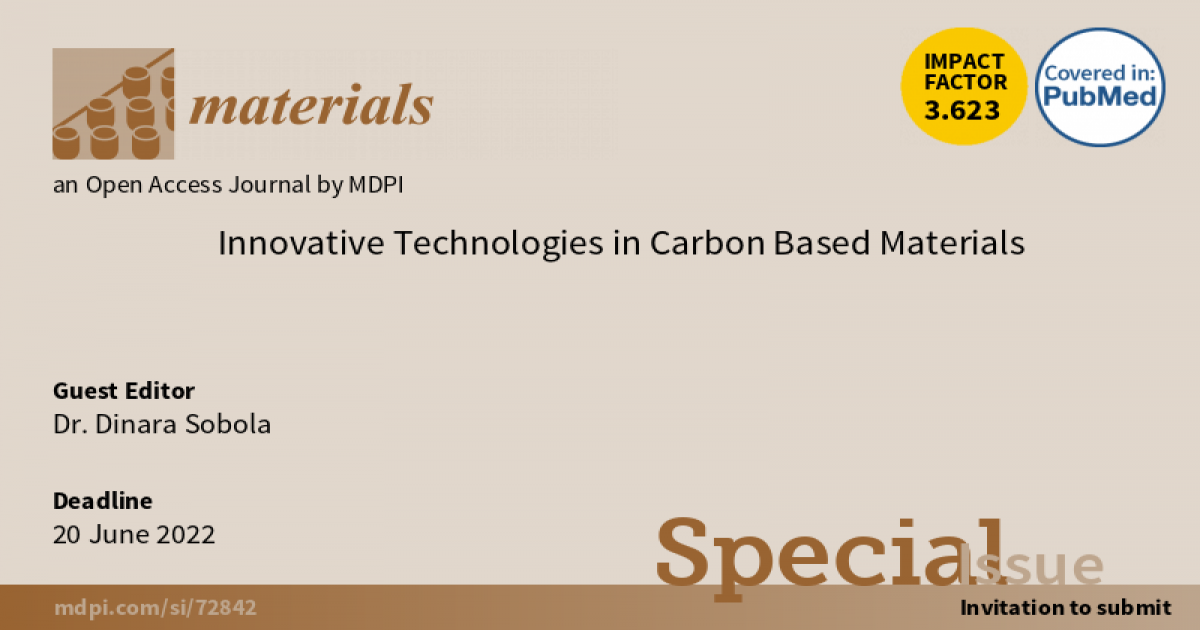- 3.2Impact Factor
- 6.4CiteScore
- 16 daysTime to First Decision
Innovative Technologies in Carbon Based Materials
This special issue belongs to the section “Carbon Materials“.
Special Issue Information
Dear Colleagues,
This Special Issue is devoted to the description of technologies for the preparation of a wide range of carbon and carbon-containing materials, as well as the characterization of their structure and properties. The depiction of new approaches and experimental methods for research on carbon materials is suitable for this Special Issue.
Carbon is one of the most intriguing elements in the periodic table. While some carbon materials are already widely used in industry, others are the focus of attention of researchers in both fundamental and applied sciences. Carbon has several types of electron hybridization, such as sp3 (diamond), sp2 (graphite), sp (carbyne), as well as mixed hybridization. The nanostructured forms of such materials have a high potential for various high-tech applications.
The biocompatibility of carbon materials with living tissue provides wide opportunities for their use in ophthalmology, dermatology, dentistry, neurosurgery, cardiology and orthopedics. Progress in the field of carbon materials leads to the enhancement of technologies and minimization of costs in such industries as waste processing, production of catalysts, filters, sorption technologies, steel production, lubricants, electric motors, rocket engines, aircraft and rocket parts, mechanical engineering, energy harvesting and storage, production of sports equipment, electrodes in batteries, and active bio supplements.
Advanced carbon and carbon-containing materials require intensive studies of dimensional effects for further application in modern technologies. The aim of this Special Issue is a generalization of new experimental and theoretical data in the field of carbon materials.
You are welcome to submit a manuscript(s) for this Special Issue. Full papers, communications, and reviews are suitable and expected.
Dr. Dinara Sobola
Guest Editor
Manuscript Submission Information
Manuscripts should be submitted online at www.mdpi.com by registering and logging in to this website. Once you are registered, click here to go to the submission form. Manuscripts can be submitted until the deadline. All submissions that pass pre-check are peer-reviewed. Accepted papers will be published continuously in the journal (as soon as accepted) and will be listed together on the special issue website. Research articles, review articles as well as short communications are invited. For planned papers, a title and short abstract (about 250 words) can be sent to the Editorial Office for assessment.
Submitted manuscripts should not have been published previously, nor be under consideration for publication elsewhere (except conference proceedings papers). All manuscripts are thoroughly refereed through a single-blind peer-review process. A guide for authors and other relevant information for submission of manuscripts is available on the Instructions for Authors page. Materials is an international peer-reviewed open access semimonthly journal published by MDPI.
Please visit the Instructions for Authors page before submitting a manuscript. The Article Processing Charge (APC) for publication in this open access journal is 2600 CHF (Swiss Francs). Submitted papers should be well formatted and use good English. Authors may use MDPI's English editing service prior to publication or during author revisions.
Keywords
- graphite
- carbon composite material
- electrode
- fullerene
- carbon nanotube
- low dimensional structure
- carbon catalyst
- carbon materials in medicine

Benefits of Publishing in a Special Issue
- Ease of navigation: Grouping papers by topic helps scholars navigate broad scope journals more efficiently.
- Greater discoverability: Special Issues support the reach and impact of scientific research. Articles in Special Issues are more discoverable and cited more frequently.
- Expansion of research network: Special Issues facilitate connections among authors, fostering scientific collaborations.
- External promotion: Articles in Special Issues are often promoted through the journal's social media, increasing their visibility.
- e-Book format: Special Issues with more than 10 articles can be published as dedicated e-books, ensuring wide and rapid dissemination.

